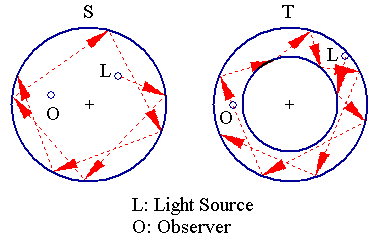

On 31/10/2005, the author posted this problem to sci.optics and sci.physics. The problem is described in more detail below.
Consider the following optical structures:
Here are some interesting questions for you to ponder about:
The central problem above is the general case of what happens in two dimensions, which was a question posed by Costas Vlachos on sci.math:
Suppose a user shines a beam of light (say a laser) inside a perfectly reflective unit circle. Which points will be visited by the light ray and which will not?
Let us define the problem geometrically: Consider the unit circle and a user A who "shines" a laser at an angle θ from the tangent at A. Clearly we have:
ρ+2*φ=π,
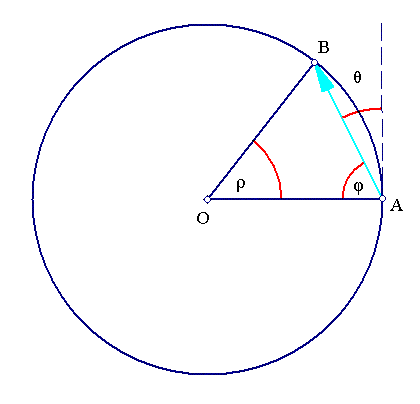
Immediately then, when θ=π/n, n in N, ρ=2*π/n, and the resulting path will be a regular polygon with n sides. Therefore the visited points are exactly the n-th roots of unity: zn=1, or explicitly the points e2*k*π/n*i, k in {0,1,2,...,n-1}.
What about points which cannot be visited? These are the points z on the unit circle which do not satisfy zn=1, or the points e2*ρ*π*i, with ρ in R\Q.
Because ρ is also the central angle, these points are the points whose central angle ρ is not a rational multiple of 2*π. In other words, they are the points whose central angle ρ is an irrational multiple of 2*π.
The n-th roots of unity are dense on the unit circle, hence for any non-visited point subtending an (irrational) angle ρ, there exists n1, n2 in N, and consequently θ1, θ2, such that for any ε>0, we have |θ1-θ2|=π*|1/n1-1/n2|<ε, and that there exist points p1 on the path of shooting angle θ1 and p2 on the path of shooting angle θ2, such that: angle(p1) < ρ < angle(p2).
In other words, we can come as close as we want to the non-visited (irrational) points, by choosing appropriate angles θ1 and θ2.
Are the angles θ=π/n the only angles which give n-th roots of unity? On sci.math someone observed that the angle θ can be of the form θ=k/n*π, k in {0,1,2,...,n-1} and made the following conjecture:
For any ρ=m/n*2*π where m and n are relatively prime the light ray will trace out the endpoints of a regular n sided polygon, though not necessarily in the correct order.
The conjecture then can be reformulated in terms of θ as:
For any θ=k/n*π the light ray will trace out the endpoints of a regular n/GCD(k,n) sided polygon, though not necessarily in the correct order.
Indeed, the n-th roots of unity form a cyclic group of order n and the elements of this group of order k with GCD(k,n)=1 are generators. The situation is depicted on the following figure for n=6:
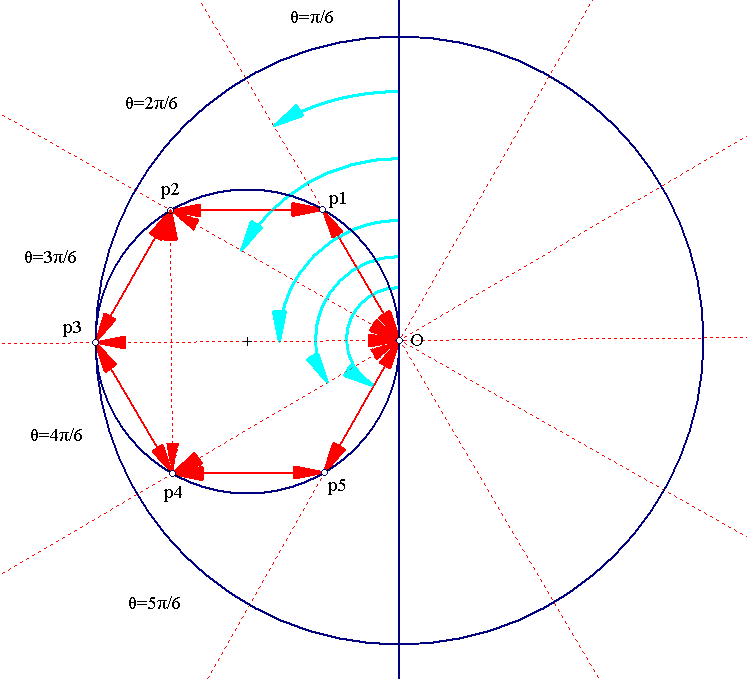
The paths traced according to the shooting angle θ are:
The cases 2,3 and 4 exhibit subgroups of the cyclic group of order 6 formed by the second, third and fourth elements.
When considering the orbit of the sequence {z,cz,ccz,...} for various c in C, it turns out that the unit circle is exactly the boundary which separates the convergent sequences from the divergent ones.
Consider the map: φ:C -> C, defined by: φ(t)=et/et. φ is invertible. Specifically, φ-1(c)=-W(-log(c)), where W is Lambert's function.
When t=φ-1(c) and |t|<1, i.e., when t falls inside the unit circle, the sequence {z,cz,ccz,...} converges. When |t|>1, i.e., when t falls outside the unit circle, the sequence diverges.
When t is ON the unit circle, things are very interesting.
Specifically, when tk=φ-1(c) is an n-th root of unity (i.e., when tk=e2*k*π/n*i, k in {0,1,2,...,n-1}), the sequence {z,cz,ccz,...} converges when z=etk or falls into periodic cycling of period p=n/GCD(n,k) when z =/= etk.
When the sequence falls into periodic cycling, the orbit trajectory traces various (irregular) polygons, similar to the polygons on the light-mirror problem. Here is the orbit of the above sequence for tk=e2*k*π/6*i, i.e., for n=6 and k in {1,2,...,5}, with z perturbed -1/2 away from etk.
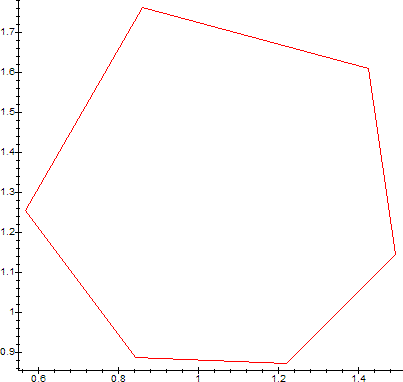
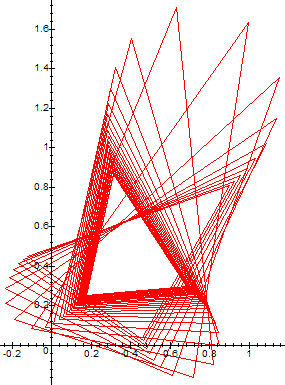
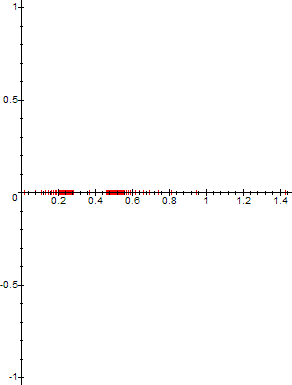
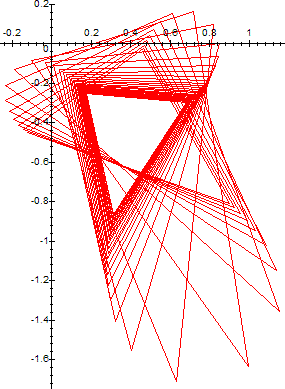
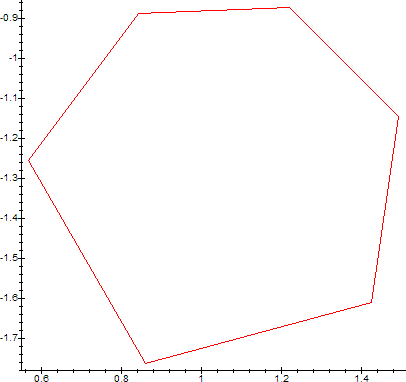
What happens to points for which |t|=1, but t=φ-1(c) is NOT an n-th root of unity? These points correspond to the points which subtend a central angle ρ which is an irrational multiple of 2*π on the problem with the light-mirror trajectory. In this case, the sequence {z,cz,ccz,...} diverges (chaotically)[2].